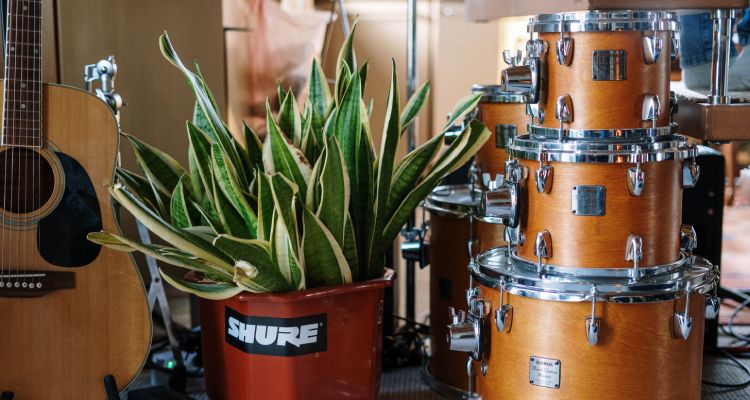As much as we’d all love to have our drum kits set up at all times, circumstances often lead us to store them away. While storing your drum kit may seem like a simple task, there are things to know about that may damage your drum gear.
Knowing how to store a drum set safely will preserve the quality of your drums for as long as possible. So, here’s a guide on drum set storage with some explanations on how to store gear as safely as possible.
Contents
Why Store a Drum Set Safely?
Storing a drum set safely preserves its condition, protects it from damage, and ensures optimal performance and longevity.
When packing your practice space up, you may be wondering how important it is to store the gear safely. After all, stacking the drums on top of each other and keeping the hardware in a pile may not seem like the worst thing in the world.
However, storing the gear like that definitely isn’t optimal, and it may lead to damage over time. The more careful you are with your gear, the longer it will last. So, it’s important to be intentional about keeping everything packed away securely. Knowing how to store a drum set will allow you to do this.
If you have multiple drum kits, these tips and tricks will be essential for all the kits that you aren’t using. Knowing how to store drums safely isn’t something that everyone is naturally inclined to, so let’s dive in.
Proper Storage Maintains Sound Quality
Ultimately, proper storage will help maintain the sound quality of your drums. Plus, by protecting them from unnecessary damage such as knocks, dents, or scratches, you can ensure that they will last many years of service.
Keeping your drums stored correctly and in a temperature controlled environment will also help to keep your drums in tune for longer so they will continue to sound good each time they are setup.
Correct Storage Preserves the Finish
Furthermore, drums are cherished not only for their sound but also for their appearance. Correct storage techniques safeguard the finish, color, and overall aesthetic appeal of your drums. This ensures that they continue to look impressive on stage or in a studio setting.
Having your drums kept in either a mint or good condition will not only keep them looking better for longer, but it also means they will retain a higher value in the long-term and will be worth more if you were to ever sell them.
Essentials Needed to Store a Drum Set Safely
The 3 main things you need to think of when storing your drums are the drums themselves, the cymbals, and the hardware. Luckily, you can get storage bags that are specifically designed for all these parts.
So, getting the bags is where you’ll need to start. Once you have the bags, you can sort all your gear into them.
Drum Bags

There are two main types of storage cases for drums. These are soft bags and hard cases. Soft bags are much lighter and easier to carry around. Hard cases offer more protection to your drums. Depending on how often you move your drums around, you’ll have to choose which type of drum case to get.
If you’re simply going to store the drums away for a while, I highly suggest getting hard cases. Hard cases are also easier to stack on top of each other as their shape is often quite rigid. Stacking your drums like this will be the most efficient way of saving space when storing them.
You should consider getting soft cases if you’re playing lots of gigs with your stored kit. It’ll be easier to carry and load them into your car.
Cymbal Bag
While each drum needs an individual case, you thankfully only need one bag for your cymbals. Cymbal bags generally have sleeves inside them that allow you to separate each cymbal and stop them from rubbing against each other.
You might need two bags if you have a large collection of cymbals. Having too many cymbals in one bag will put strain on it and damage the bag over time.
Hardware Case
The final aspect of your setup to think about is all the hardware. This includes cymbal stands, pedals, and tom mounts. Musicians often refer to the hardware case as “the steels case”. Similar to the other types of cases, you can also get either a soft or hard case for the hardware.
However, a hard case is arguably your best option as the case can get very heavy with all the hardware stored inside. It’s incredibly common for soft cases to rip after a while with hardware stored inside.
Storing the Drums
Positioning in a Room
The biggest choice you’re going to have to make when storing your drums is deciding where exactly to place them. Drums take up a fairly large amount of space, so clever positioning is key to saving as much space as possible. It’s also important in protecting the drums from any potential damage that may occur.
One of the best places in a room to store drums is in the corner. Putting the drums in the corner will only give you one way of reaching them and give them the added protection of walls on either side. The two walls will stop the drums from falling sideways for any reason.
Hardware should be placed on the floor. Since hardware bags are incredibly heavy, you don’t want to put them in a position where they could fall and do some damage. Cymbals, on the other hand, should be placed in an upright position.
If you place cymbals on the floor, there’s a chance that they could be stepped on which isn’t great. I’ve found one of the best places to store cymbals is upright behind a door where no one could possibly stand on them or knock them over.
Stacking Shells

The best way to preserve space with your drums is to stack the shells on top of each other. You could do this whether they’re in drum bags or not. People generally refer to this as a drum kit Christmas tree.
If you don’t have bags covering the drums, they can actually look quite cool in a room as a decoration. I’ve seen plenty of drummers stack multiple drum kits like this in their practice room for aesthetic purposes.
Make sure you stack the drums from biggest to smallest to ensure that the structure is sturdy. It typically works quite well if you have a large bass drum at the bottom.
If you have a huge drum kit with several toms, you may need to split it up into two stacks to ensure that the stack isn’t too high and wobbly.
Traveling in a Car
Another thing to think about with drum storage is how to transport your drums correctly in a vehicle. This is something all gigging drummers have to deal with in their careers. There’s a bit of potential for your drums to get damaged in the car, especially over long and bumpy trips.
When packing your vehicle, you’ll need to stack drum cases or wrapped drums carefully. Always place heavier items (like your hardware case and bass drum) on the bottom and lighter ones on top. Also, make sure nothing is loose and able to roll around while in transit.
If you want to preserve your gear as best as possible, having drum bags should be a non-negotiable when storing the drums in a car. These provide protection against impacts and scratches. Hard cases offer more protection than bags, but are also heavier and more expensive.
Once you have all the gear in bags, you should carefully decide how to place all the drums so that they’re easy to take out again on the other side of the trip.
The bass drum is the biggest thing to worry about when packing your drums in a car. You should place that first and then position everything else around that. Once you’ve managed to fit the bass drum in the car, everything else should be a bit easier to place.
It helps massively if you’re traveling in a car with a large trunk. Hardware, cymbals, and all the smaller drum shells can typically fit quite nicely in there. The rest of the drums will have to be placed along with the bass drum in the backseat.
Storage Tips
Once you have all your drum gear packed into bags, there are a few things to take note of when storing the gear in specific places. Positioning, weather, prioritizing gear, and extra gear are all things that you should think about.

Take Weather into Account
Weather is one of the biggest causes of damage to drum gear over time. It’s a silent killer as we often don’t notice until it’s too late. Dampness in a house can cause the metal parts of a kit to rust, leaving those parts to look old and worn.
You don’t need to worry about this as much if all your gear is stored in cases or bags, but it can still come through a bit. The best way to avoid it is to keep all your stored drums away from windows and keep them in spaces where there is enough breathing room.
Giving your drums a regular dust-up is another good way of stopping weather damage over time.
Climate Control Plays a Role in Drum Storage
-
Temperature Stability: Extreme temperature such as extreme heat or cold can cause wood to expand or contract, potentially leading to warping of drum shells. Aim to store your drums in a climate-controlled environment.
-
Protection Against Moisture: Moisture is a drum’s enemy, as it can lead to rust, corrosion, and deterioration of hardware components like screws, lugs, and hoops. Climate control helps mitigate moisture-related issues, especially in areas with high humidity or during seasonal changes.
Storage Units
If you don’t have the space to store your drums in the place that you live in, you should consider hiring a storage space. Many drummers do this, and some even use those spaces to set up and practice in.
Putting all your drum cases and bags is one of the best ways to keep your house clutter-free. Even in their cases, drums tend to take up a lot of space. So, it’s an option you should consider!
Just be wary of weather damage and dust since you’re not likely to be around in the storage unit as you are in your own household.
Final Thoughts
If you store your drums away properly and safely, the quality of the drums will be preserved for dozens of years. Shells and hardware only get damaged when they’re not taken care of meticulously. Knowing how to store drums is a vital thing that all drummers should know.
Just remember to pull the drums out of the bags every now and then to wipe them down and make sure that everything is okay.
A set of drum cases is something every drummer needs. This is especially true for storing the drums safely. So, get some drum, cymbal, and hardware cases and put your drums in a spot that will keep them safe from any damage.









